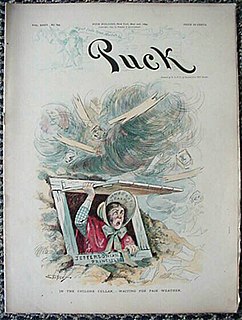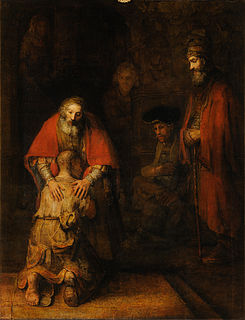Related Research Articles

A metaphor is a figure of speech that, for rhetorical effect, directly refers to one thing by mentioning another. It may provide clarity or identify hidden similarities between two different ideas. Metaphors are often compared with other types of figurative language, such as antithesis, hyperbole, metonymy and simile. One of the most commonly cited examples of a metaphor in English literature comes from the "All the world's a stage" monologue from As You Like It:
A simile is a figure of speech that directly compares two things. Similes differ from other metaphors by highlighting the similarities between two things using comparison words such as "like", "as", "so", or " than", while other metaphors create an implicit comparison. This distinction is evident in the etymology of the words: simile derives from the Latin word similis, while metaphor derives from the Greek word metapherein. While similes are mainly used in forms of poetry that compare the inanimate and the living, there are also terms in which similes are used for very important things.

A parable is a succinct, didactic story, in prose or verse, that illustrates one or more instructive lessons or principles. It differs from a fable in that fables employ animals, plants, inanimate objects, or forces of nature as characters, whereas parables have human characters. A parable is a type of metaphorical analogy.
Literal and figurative language is a distinction within some fields of language analysis, in particular stylistics, rhetoric, and semantics.

The telautograph, an analog precursor to the modern fax machine, transmits electrical impulses recorded by potentiometers at the sending station to servomechanisms attached to a pen at the receiving station, thus reproducing at the receiving station a drawing or signature made by the sender. It was the first such device to transmit drawings to a stationary sheet of paper; previous inventions in Europe had used rotating drums to make such transmissions.
Win32/Simile is a metamorphic computer virus written in assembly language for Microsoft Windows. The virus was released in its most recent version in early March 2002. It was written by the virus writer "Mental Driller". Some of his previous viruses, such as Win95/Drill, have proved very challenging to detect.

The Cotton States and International Exposition Speech was an address on the topic of race relations given by Booker T. Washington on September 18, 1895. The speech laid the foundation for the Atlanta compromise, an agreement between African-American leaders and Southern white leaders in which Southern blacks would work meekly and submit to white political rule, while Southern whites guaranteed that blacks would receive basic education and due process of law.
Equative is a case prototypically expressing the standard of comparison of equal values. The equative case has been used in very few languages in history. It was used in the Sumerian language, where it also took on the semantic functions of the essive case and similative case.
Hypocatastasis is a figure of speech that declares or implies a resemblance, representation or comparison. It differs from a metaphor, because in a metaphor the two nouns are both named and given; while, in hypocatastasis, only one is named and the other is implied, or as it were, is put down underneath out of sight. Hence hypocatastasis is an implied resemblance or representation: that is an implied simile or metaphor. A hypocatastasis has more force than a metaphor or simile, and expresses as it were a superlative degree of resemblance.
SIMILE was a joint research project run by the World Wide Web Consortium (W3C), Massachusetts Institute of Technology Libraries and MIT CSAIL and funded by the Andrew W. Mellon Foundation. The project ran from 2003 to August 2008. It focused on developing tools to increase the interoperability of disparate digital collections. Much of SIMILE's technical focus is oriented towards Semantic Web technology and standards such as Resource Description Framework (RDF).

Sonnet 84 is one of 154 sonnets published by the English playwright and poet William Shakespeare in 1609. It's part of the Fair Youth sequence, and the seventh sonnet of the Rival Poet group.
Homeric simile, also called an epic simile, is a detailed comparison in the form of a simile that are many lines in length. The word "Homeric", is based on the Greek author, Homer, who composed the two famous Greek epics, the Iliad and the Odyssey. Many authors continue to use this type of simile in their writings although it is usually found in classics.
Ullurai is a type of extended allusion or metaphor used in classical Tamil poetry.
Protonarthrini is a tribe of longhorn beetles of the subfamily Lamiinae. It was described by Thomson in 1864.
Brachynarthron is a genus of longhorn beetles of the subfamily Lamiinae, containing the following species:

Simile is the Black township on the northern side of the forestry town Sabie. It falls under the Thaba Chweu Local Municipality of Mpumalanga province, South Africa.

An animal epithet is a name used to label a person or group, by association with some perceived quality of an animal. Epithets may be formulated as similes, explicitly comparing people with the named animal, or as metaphors, directly naming people as animals. Animal epithets may be pejorative, readily giving offence, and they are sometimes used in political campaigns. One English epithet, lamb, is always used positively.
Brachynarthron aeneipennis is a species of beetle in the family Cerambycidae. It was described by Stephan von Breuning in 1956. It is known from Ghana.
Brachynarthron unicoloripennis is a species of beetle in the family Cerambycidae. It was described by Stephan von Breuning in 1968. It is known from the Ivory Coast.

Comparison or comparing is the act of evaluating two or more things by determining the relevant, comparable characteristics of each thing, and then determining which characteristics of each are similar to the other, which are different, and to what degree. Where characteristics are different, the differences may then be evaluated to determine which thing is best suited for a particular purpose. The description of similarities and differences found between the two things is also called a comparison. Comparison can take many distinct forms, varying by field:
To compare is to bring two or more things together and to examine them systematically, identifying similarities and differences among them. Comparison has a different meaning within each framework of study. Any exploration of the similarities or differences of two or more units is a comparison. In the most limited sense, it consists of comparing two units isolated from each other.
References
- ↑ BioLib.cz - Brachynarthron simile. Retrieved on 8 September 2014.